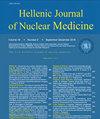A pictorial view on false positive findings of 68Ga-PSMA-11 PET/CT and their prognostic value in patients with prostate carcinoma after radical prostatectomy and undetectable PSA values.
IF 0.9
4区 医学
Q4 RADIOLOGY, NUCLEAR MEDICINE & MEDICAL IMAGING
引用次数: 0
Abstract
OBJECTIVE Recently, gallium-68-prostate-specific membrane antigen-11 (68Ga-PSMA-11) positron emission tomography/computed tomography (PET/CT) has become a key imaging method in prostate carcinoma staging and biochemical progression, with varying sensitivities in different studies (from 40% to 80%). After four years of experience with 68Ga-PSMA-11 PET/CT, we found that it is possible to detect lesions with increased PSMA expression in patients with undetectable prostate specific antigen (PSA) levels after radical prostatectomy. The key questions we wanted to answer were as follows: if those lesions were malignant and could the early detection of those malignant lesions have a role in patient management? We aimed to identify and follow up PSMA-positive findings for a period of 4 years in patients with prostate cancer after radical prostatectomy and undetectable PSA values at the time of the examination. We also explored false-positive lesions in detail. SUBJECTS AND METHODS The study included all patients who underwent radical prostatectomy and had undetectable PSA values <0.05ng/mL and who underwent 68Ga-PSMA-11 PET/CT between July 2019 and December 2019. We performed 220 studies and found 40 patients with these characteristics; these patients were included in this study. All of them were followed up until July 2023. Any finding with increased radiopharmaceutical accumulation above the background activity in the respective area was considered a false positive. Prostate-specific membrane antigen accumulation in established lesions was assessed semiquantitatively by the maximum standardized uptake value (SUVmax) and qualitatively by the four-point visual scale proposed in the E-PSMA recommendations. RESULTS We found 15/40 (37.5%) patients with PSMA-positive findings. These were predominantly bone changes without a corresponding CT abnormality or discrete cystic or osteoblastic lesions with above-background increased PSMA expression. The mean SUVmax of these nonspecific lesions was 3.02 (SD 2.86). After 3.5-4 years of follow-up, biochemical progression was found in only two of the patients.The great sensitivity of the method nowadays is a powerful engine for the development of new therapeutic options. On the other side, the lower specificity due to false positive findings, if misinterpreted, might lead to switching to a higher stage, with the planned radical treatment replaced by palliative treatment. CONCLUSION The presence of 68Ga-PSMA-11 PET/CT-positive findings in patients after radical prostatectomy and an undetectable PSA had a low predictive value for future progression. The interpretation of 68Ga-PSMA-11 PET/CT should always include a complex assessment of the clinical setting-the risk group, PSA value and degree of PSMA accumulation in the lesions. In these situations, further clarification of PSMA-positive findings is appropriate before deciding to change treatment.68Ga-PSMA-11 PET/CT 的假阳性结果及其在前列腺癌根治术后检测不到 PSA 值的患者中的预后价值图解。
目的最近,镓-68-前列腺特异性膜抗原-11(68Ga-PSMA-11)正电子发射断层扫描/计算机断层扫描(PET/CT)已成为前列腺癌分期和生化进展的关键成像方法,不同研究的灵敏度各不相同(从 40% 到 80%)。经过四年使用 68Ga-PSMA-11 PET/CT 的经验,我们发现在根治性前列腺切除术后检测不到前列腺特异性抗原(PSA)水平的患者中,可以检测到 PSMA 表达增加的病灶。我们想回答的关键问题如下:这些病变是否是恶性的,以及早期发现这些恶性病变能否在患者管理中发挥作用?我们的目标是在前列腺癌根治术后且检查时未检测到 PSA 值的患者中发现 PSMA 阳性结果,并对其进行为期 4 年的随访。我们还详细探讨了假阳性病变。研究对象和方法研究纳入了所有接受前列腺癌根治术且检测不到 PSA 值 <0.05ng/mL 的患者,这些患者在 2019 年 7 月至 2019 年 12 月期间接受了 68Ga-PSMA-11 PET/CT 检查。我们进行了 220 项研究,发现 40 名患者具有上述特征;这些患者被纳入本研究。我们对所有患者进行了随访,直至 2023 年 7 月。任何在相应区域放射性药物蓄积量高于背景活性的发现都被视为假阳性。通过最大标准化摄取值(SUVmax)对已确定病灶中的前列腺特异性膜抗原蓄积进行半定量评估,并通过 E-PSMA 建议中提出的四点视觉量表进行定性评估。这些主要是没有相应 CT 异常的骨质改变,或者是 PSMA 表达高于背景的离散性囊性或成骨细胞病变。这些非特异性病变的平均 SUVmax 为 3.02(标清 2.86)。经过 3.5-4 年的随访,只有两名患者出现了生化进展。另一方面,由于假阳性结果导致特异性较低,如果被误读,可能会导致患者转入更高阶段,原计划的根治性治疗被姑息性治疗所取代。68Ga-PSMA-11 PET/CT 的解释应始终包括对临床环境的复杂评估--风险组别、PSA 值和病变中 PSMA 的积聚程度。在这些情况下,在决定改变治疗方法之前,应进一步明确 PSMA 阳性结果。
本文章由计算机程序翻译,如有差异,请以英文原文为准。
求助全文
约1分钟内获得全文
求助全文
来源期刊
CiteScore
1.40
自引率
6.70%
发文量
34
审稿时长
>12 weeks
期刊介绍:
The Hellenic Journal of Nuclear Medicine published by the Hellenic Society of
Nuclear Medicine in Thessaloniki, aims to contribute to research, to education and
cover the scientific and professional interests of physicians, in the field of nuclear
medicine and in medicine in general. The journal may publish papers of nuclear
medicine and also papers that refer to related subjects as dosimetry, computer science,
targeting of gene expression, radioimmunoassay, radiation protection, biology, cell
trafficking, related historical brief reviews and other related subjects. Original papers
are preferred. The journal may after special agreement publish supplements covering
important subjects, dully reviewed and subscripted separately.

 求助内容:
求助内容: 应助结果提醒方式:
应助结果提醒方式:


